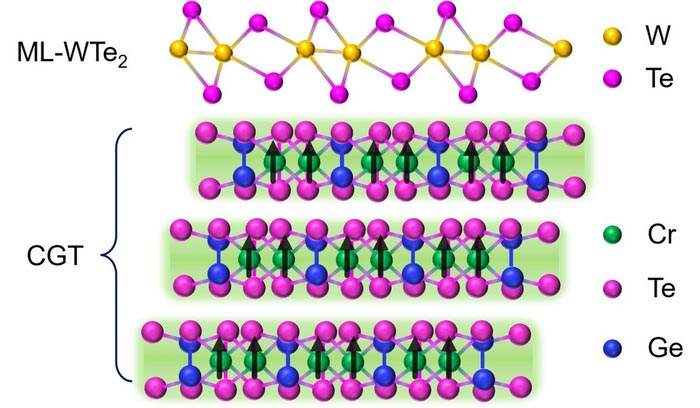Researchers devise tunable conducting edge

In their experiments, the researchers stacked monolayer WTe2 with Cr2Ge2Te6, or CGT.
Credit: Shi lab, UC Riverside
Technology reported in UC Riverside-led study has nanoelectronic applications.
A research team led by a physicist at the University of California, Riverside, has demonstrated a new magnetized state in a monolayer of tungsten ditelluride, or WTe2, a new quantum material. Called a magnetized or ferromagnetic quantum spin Hall insulator, this material of one-atom thickness has an insulating interior but a conducting edge, which has important implications for controlling electron flow in nanodevices.
In a typical conductor, electrical current flows evenly everywhere. Insulators, on the other hand, do not readily conduct electricity. Ordinarily, monolayer WTe2 is a special insulator with a conducting edge; magnetizing it bestows upon it more unusual properties.
“We stacked monolayer WTe2 with an insulating ferromagnet of several atomic layer thickness — of Cr2Ge2Te6, or simply CGT — and found that the WTe2 had developed ferromagnetism with a conducting edge,” said Jing Shi, a distinguished professor of physics and astronomy at UCR, who led the study. “The edge flow of the electrons is unidirectional and can be made to switch directions with the use of an external magnetic field.”
Shi explained that when only the edge conducts electricity, the size of the interior of the material is inconsequential, allowing electronic devices that use such materials to be made smaller — indeed, nearly as small as the conducting edge. Because devices using this material would consume less power and dissipate less energy, they could be made more energy efficient. Batteries using this technology, for example, would last longer.
Study results appear in Nature Communications.
Currently, the technology works only at very low temperatures; CGT is ferromagnetic at around 60 K (or -350 F). The goal of future research would be to make the technology work at higher temperatures, allowing for many nanoelectronic applications such as non-volatile memory chips used in computers and cell phones.
According to Shi, the conducting edge in ideal quantum spin Hall insulators comprises two narrow channels running alongside each other, akin to a two-lane highway with cars driving in opposite directions. Electrons flowing in one channel cannot cross over to the other channel, Shi said, unless impurities are introduced. The conducting edge in monolayer WTe2 was first visualized in an earlier study by coauthor Yongtao Cui, an associate professor of physics and astronomy at UCR and Shi’s colleague.
“It is two channels per edge,” Shi said. “If you eliminate one channel, you end up with a current flowing only in one direction, leaving you with what is called a quantum anomalous Hall insulator, yet another special quantum material. Such an insulator has only one highway lane, to use the highway analogy. This insulator transports electrons in a fully spin-polarized manner.”
On the other hand, the magnetized WTe2 that Shi and his colleagues experimented with is called a ferromagnetic quantum spin Hall insulator, which has a conducting edge with partially spin-polarized electrons.
“In the two channels of ferromagnetic quantum spin Hall insulators, we have an unequal number of electrons flowing in opposite directions resulting in a net current, which we can control with an external magnet,” Shi said.
According to Shi, quantum materials such as WTe2 are the future of nanoelectronics.
“The CHIPS Act will encourage researchers to come up with new materials whose properties are superior to those of current silicon materials,” he said.
Shi was joined in the study by Cui and Xi Chen at UCR as well as the following researchers in their labs: Mina Rashetnia, Mark Lohmann, and Youming Xu. First author Junxue Li was a postdoctoral researcher in Shi’s lab when the research was done. Other coauthors on the paper are Jahyun Koo and Binghai Yan of the Weizmann Institute of Science in Israel; Xiao Zhang and Shuang Jia of Peking University in China; and Kenji Watanabe and Takashi Taniguchi of the National Institute for Materials Science in Japan.
Shi was supported in the research by grants from the Department of Energy and National Science Foundation.
The title of the paper is “Proximity-magnetized quantum spin Hall insulator: monolayer 1 T’ WTe2/Cr2Ge2Te6.”
The University of California, Riverside is a doctoral research university, a living laboratory for groundbreaking exploration of issues critical to Inland Southern California, the state and communities around the world. Reflecting California’s diverse culture, UCR’s enrollment is more than 26,000 students. The campus opened a medical school in 2013 and has reached the heart of the Coachella Valley by way of the UCR Palm Desert Center. The campus has an annual impact of more than $2.7 billion on the U.S. economy. To learn more, visit www.ucr.edu.
Journal: Nature Communications
DOI: 10.1038/s41467-022-32808-w
Method of Research: Experimental study
Subject of Research: Not applicable
Article Title: Proximity-magnetized quantum spin Hall insulator: monolayer 1 T’ WTe2/Cr2Ge2Te6.
Article Publication Date: 1-Sep-2022
COI Statement: No conflict of interest.
All latest news from the category: Materials Sciences
Materials management deals with the research, development, manufacturing and processing of raw and industrial materials. Key aspects here are biological and medical issues, which play an increasingly important role in this field.
innovations-report offers in-depth articles related to the development and application of materials and the structure and properties of new materials.
Newest articles

Innovative 3D printed scaffolds offer new hope for bone healing
Researchers at the Institute for Bioengineering of Catalonia have developed novel 3D printed PLA-CaP scaffolds that promote blood vessel formation, ensuring better healing and regeneration of bone tissue. Bone is…

The surprising role of gut infection in Alzheimer’s disease
ASU- and Banner Alzheimer’s Institute-led study implicates link between a common virus and the disease, which travels from the gut to the brain and may be a target for antiviral…

Molecular gardening: New enzymes discovered for protein modification pruning
How deubiquitinases USP53 and USP54 cleave long polyubiquitin chains and how the former is linked to liver disease in children. Deubiquitinases (DUBs) are enzymes used by cells to trim protein…



